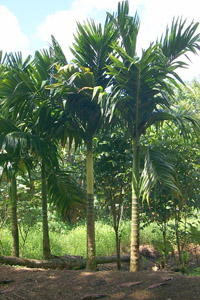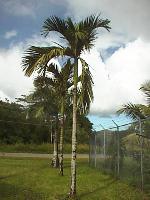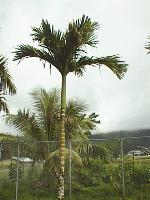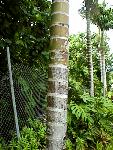







Photos taken in Sekere and Palikir.
Family: Arecaceae
English name: Betelnut
Chuukese name: Pwu
Kosraen name: Kutacr
Pohnpeian name: Pwuh
Yapese name: Pu'u
Location collected: Palm Terrace, Agriculture Station at COM-FSM campus
Date collected: November 28, 1998
Collected by: Brigeen Perman
Vegetative characteristics:
Habit: Tree
Leaf shape and morphology: dark green large leaves, even pinately compound, divided once, leaflets linear parallel venation; long sheaths ripped at the base
Stem type: Round lignified stem with abvious nodes
Floral characteristics: produce fruits on a branched peduncle below the leaves; male flowers are produced toward the inflorescence branches and female flowers at the base
Cultural significance of betelnut tree in YAP On the island of Yap, there are alot of uses of the betelnut tree. Uses of it started from the root all the way up to the leaves. Close to the coconut tree, the betelnut tree do serve alot of purposes too. Below are some of the purposes each part of the tree serves to the needs of the people in Yap.
STEM: The stem of the betelnut tree is long, hollow in the inside but hard on the outside. There are alot of uses of this part of a betelnut tree. The first well known use is for building houses, benches, pig pens, and alot of others. How is it prepared ?? First cut down the betelnut tree. Then cut the stem with the measurement a person need for each specific use. Then the outer layer of the stem is being carved off. The stem then is divided into halfs by cutting it in a vertical line from the top of the stem to the bottom of the stem.
The FRUITS: The fruits are well known for chewing. How is it prepared?? First add some burnt lime (hydrated calcium oxide) with one betel nut, preferably in a semi-powdered form. Then wrap around the betel nut with a certain type of leaf (Piper chavica). Place in the side of the mouth, like a plug of tobacco, and start masticating on it. Spit the saliva of the chew out. Too much of the powder lime can burn your mouth. Though the cause of chewing with lime does burn and destroy small mouth tissue.
The LEAVES: The leaves of the betel nut tree has a lot of purpose too. On the island of Yap, the leaves of the betel nut tree is used to make grass skirts for local dances. The leaf is cut down than is split into two halves. The compound leaves on each half is then loosen but extracting the middle needle-like spinal for each long leaf. It is then wrapped around the waist area as the grass skirt. Another usage of the leaves is for making leis (mwaramar).
Rufino Xavier